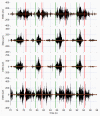Assessment of a Passive Lumbar Exoskeleton in Material Manual Handling Tasks under Laboratory Conditions
- PMID: 35684682
- PMCID: PMC9185583
- DOI: 10.3390/s22114060
Assessment of a Passive Lumbar Exoskeleton in Material Manual Handling Tasks under Laboratory Conditions
Abstract
Manual material handling tasks in industry cause work-related musculoskeletal disorders. Exoskeletons are being introduced to reduce the risk of musculoskeletal injuries. This study investigated the effect of using a passive lumbar exoskeleton in terms of moderate ergonomic risk. Eight participants were monitored by electromyogram (EMG) and motion capture (MoCap) while performing tasks with and without the lumbar exoskeleton. The results showed a significant reduction in the root mean square (VRMS) for all muscles tracked: erector spinae (8%), semitendinosus (14%), gluteus (5%), and quadriceps (10.2%). The classic fatigue parameters showed a significant reduction in the case of the semitendinosus: 1.7% zero-crossing rate, 0.9% mean frequency, and 1.12% median frequency. In addition, the logarithm of the normalized Dimitrov's index showed reductions of 11.5, 8, and 14% in erector spinae, semitendinosus, and gluteus, respectively. The calculation of range of motion in the relevant joints demonstrated significant differences, but in almost all cases, the differences were smaller than 10%. The findings of the study indicate that the passive exoskeleton reduces muscle activity and introduces some changes of strategies for motion. Thus, EMG and MoCap appear to be appropriate measurements for designing an exoskeleton assessment procedure.
Keywords: EMG; exoskeleton; fatigue; lumbar; manual material handling; motion-tracking.
Conflict of interest statement
The authors declare no conflict of interest.
Figures














Similar articles
-
Effects of industrial back-support exoskeletons on body loading and user experience: an updated systematic review.Ergonomics. 2021 Jun;64(6):685-711. doi: 10.1080/00140139.2020.1870162. Epub 2021 Mar 16. Ergonomics. 2021. PMID: 33369518
-
Biomechanical Consequences of Using Passive and Active Back-Support Exoskeletons during Different Manual Handling Tasks.Int J Environ Res Public Health. 2023 Jul 28;20(15):6468. doi: 10.3390/ijerph20156468. Int J Environ Res Public Health. 2023. PMID: 37569010 Free PMC article.
-
Evaluation of the physiological benefits of a passive back-support exoskeleton during lifting and working in forward leaning postures.J Biomech. 2023 Mar;149:111489. doi: 10.1016/j.jbiomech.2023.111489. Epub 2023 Feb 14. J Biomech. 2023. PMID: 36806003
-
Flexible sensor-based biomechanical evaluation of low-back exoskeleton use in lifting.Ergonomics. 2024 Feb;67(2):182-193. doi: 10.1080/00140139.2023.2216408. Epub 2023 May 26. Ergonomics. 2024. PMID: 37204270 Free PMC article.
-
Exoskeleton Application to Military Manual Handling Tasks.Hum Factors. 2022 May;64(3):527-554. doi: 10.1177/0018720820957467. Epub 2020 Nov 18. Hum Factors. 2022. PMID: 33203237 Review.
Cited by
-
Active back exosuits demonstrate positive usability perceptions that drive intention-to-use in the field among logistic warehouse workers.Appl Ergon. 2025 Jan;122:104400. doi: 10.1016/j.apergo.2024.104400. Epub 2024 Oct 9. Appl Ergon. 2025. PMID: 39388886
-
JcvPCA and JsvCRP: A set of metrics to evaluate changes in joint coordination strategies.PLoS One. 2025 Aug 5;20(8):e0325792. doi: 10.1371/journal.pone.0325792. eCollection 2025. PLoS One. 2025. PMID: 40763295 Free PMC article.
-
Evaluating Exoskeletons for WMSD Prevention: A Systematic Review of Applications and Ergonomic Approach in Occupational Settings.Int J Environ Res Public Health. 2024 Dec 19;21(12):1695. doi: 10.3390/ijerph21121695. Int J Environ Res Public Health. 2024. PMID: 39767533 Free PMC article.
-
Effect of Wearable Exoskeleton Robots on Muscle Activation and Gait Parameters on a Treadmill: A Randomized Controlled Trial.Healthcare (Basel). 2025 Mar 22;13(7):700. doi: 10.3390/healthcare13070700. Healthcare (Basel). 2025. PMID: 40217998 Free PMC article.
-
Assessment of Muscle Coordination Changes Caused by the Use of an Occupational Passive Lumbar Exoskeleton in Laboratory Conditions.Sensors (Basel). 2023 Dec 5;23(24):9631. doi: 10.3390/s23249631. Sensors (Basel). 2023. PMID: 38139478 Free PMC article.
References
-
- Bureau of Labour Statistics Nonfatal Occupational Injuries and Illnesses Requiring Days Away from Work. [(accessed on 23 May 2022)];2016 Available online: https://www.bls.gov/news.release/osh2.toc.htm.
-
- Colim A., Faria C., Braga A.C., Sousa N., Rocha L., Carneiro P., Costa N., Arezes P. Towards an Ergonomic Assessment Framework for Industrial Assembly Workstations—A Case Study. Appl. Sci. 2020;10:3048. doi: 10.3390/app10093048. - DOI
-
- Rossi D., Bertoloni E., Fenaroli M., Marciano F., Alberti M. A multi-criteria ergonomic and performance methodology for evaluating alternatives in “manuable” material handling. Int. J. Ind. Ergon. 2013;43:314–327. doi: 10.1016/j.ergon.2013.04.009. - DOI
MeSH terms
Grants and funding
LinkOut - more resources
Full Text Sources

